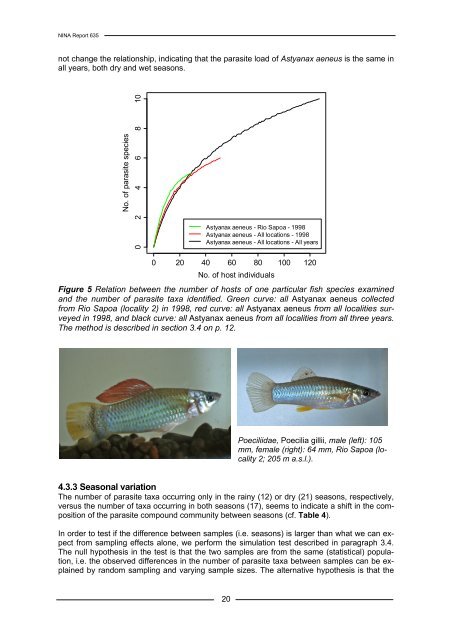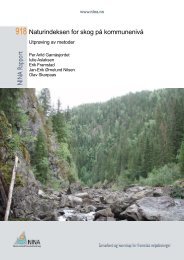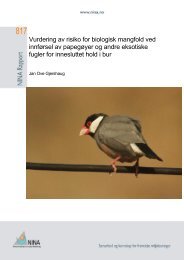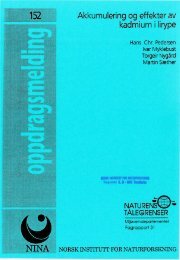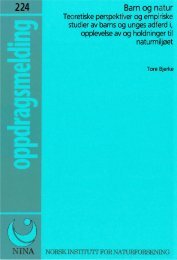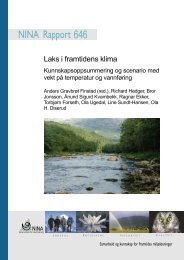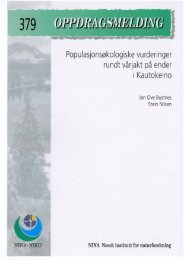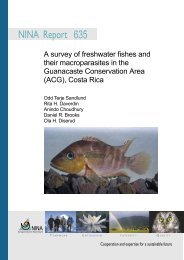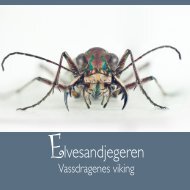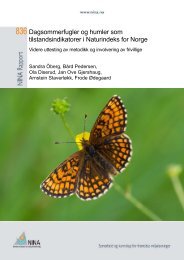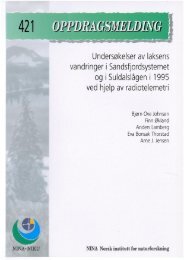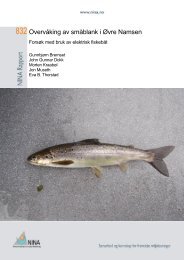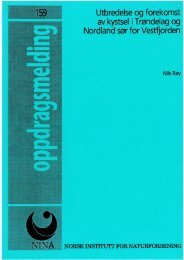A survey of freshwater fishes and their macroparasites in the ... - NINA
A survey of freshwater fishes and their macroparasites in the ... - NINA
A survey of freshwater fishes and their macroparasites in the ... - NINA
Create successful ePaper yourself
Turn your PDF publications into a flip-book with our unique Google optimized e-Paper software.
<strong>NINA</strong> Report 635<br />
not change <strong>the</strong> relationship, <strong>in</strong>dicat<strong>in</strong>g that <strong>the</strong> parasite load <strong>of</strong> Astyanax aeneus is <strong>the</strong> same <strong>in</strong><br />
all years, both dry <strong>and</strong> wet seasons.<br />
No. <strong>of</strong> parasite species<br />
0 2 4 6 8 10<br />
Astyanax aeneus - Rio Sapoa - 1998<br />
Astyanax aeneus - All locations - 1998<br />
Astyanax aeneus - All locations - All years<br />
0 20 40 60 80 100 120<br />
No. <strong>of</strong> host <strong>in</strong>dividuals<br />
Figure 5 Relation between <strong>the</strong> number <strong>of</strong> hosts <strong>of</strong> one particular fish species exam<strong>in</strong>ed<br />
<strong>and</strong> <strong>the</strong> number <strong>of</strong> parasite taxa identified. Green curve: all Astyanax aeneus collected<br />
from Rio Sapoa (locality 2) <strong>in</strong> 1998, red curve: all Astyanax aeneus from all localities <strong>survey</strong>ed<br />
<strong>in</strong> 1998, <strong>and</strong> black curve: all Astyanax aeneus from all localities from all three years.<br />
The method is described <strong>in</strong> section 3.4 on p. 12.<br />
20<br />
Poeciliidae, Poecilia gillii, male (left): 105<br />
mm, female (right): 64 mm, Rio Sapoa (locality<br />
2; 205 m a.s.l.).<br />
4.3.3 Seasonal variation<br />
The number <strong>of</strong> parasite taxa occurr<strong>in</strong>g only <strong>in</strong> <strong>the</strong> ra<strong>in</strong>y (12) or dry (21) seasons, respectively,<br />
versus <strong>the</strong> number <strong>of</strong> taxa occurr<strong>in</strong>g <strong>in</strong> both seasons (17), seems to <strong>in</strong>dicate a shift <strong>in</strong> <strong>the</strong> composition<br />
<strong>of</strong> <strong>the</strong> parasite compound community between seasons (cf. Table 4).<br />
In order to test if <strong>the</strong> difference between samples (i.e. seasons) is larger than what we can expect<br />
from sampl<strong>in</strong>g effects alone, we perform <strong>the</strong> simulation test described <strong>in</strong> paragraph 3.4.<br />
The null hypo<strong>the</strong>sis <strong>in</strong> <strong>the</strong> test is that <strong>the</strong> two samples are from <strong>the</strong> same (statistical) population,<br />
i.e. <strong>the</strong> observed differences <strong>in</strong> <strong>the</strong> number <strong>of</strong> parasite taxa between samples can be expla<strong>in</strong>ed<br />
by r<strong>and</strong>om sampl<strong>in</strong>g <strong>and</strong> vary<strong>in</strong>g sample sizes. The alternative hypo<strong>the</strong>sis is that <strong>the</strong>


